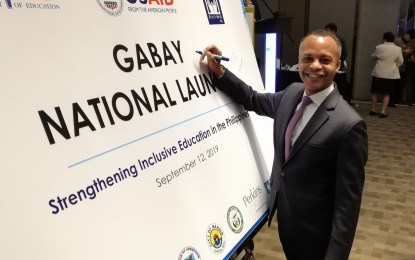
USAID Mission Director in the Philippines Lawrence Hardy II (Photo by Joyce Ann L. Rocamora)
MANILA -- The United States government on Thursday launched a PHP92.3-million project that seeks to strengthen the country's inclusive education for children with disability.
Dubbed as Gabay Project, the initiative will be led by the US Agency for International Development (USAID) and Resources for the Blind, Inc. for three years in targeted areas in Maasin City and the provinces of Batangas, Sorsogon, and Southern Leyte.
USAID Mission Director in the Philippines Lawrence Hardy II said the initiative would increase the capacity of service providers and community health workers to detect the needs of children with visual and hearing impairments.
One of its goals is also to improve the abilities of teachers in delivering appropriate learning plans for persons with disabilities.
"The United States is a strong advocate of disability policies and programs. We believe that people with disabilities have and should have all the same rights as others, including education, health, training and employment," Hardy said.
"As we launch this project today, we look forward to what is to come," he added.
Dr. Yolanda Quijano, Project Gabay's chief of party, said the project will be well-coordinated with the Department of Education and the local government units and is seen to benefit around 1,800 Filipino children with disability by the end of its implementation in June 2022.
"We want to institutionalize this in the areas and where they will become models. In the future, we want to introduce it to other local government units," she told reporters in an interview on the sidelines of the project launch.
The target beneficiaries of the program are children enrolled from Kindergarten to Grade 3 or the levels where a large percentage of kids are dropping out of school.
"One of the causes for dropping out is that some of these children could not hear well or they could not see well so they choose to drop out from school. This is when some of our teachers have a hard time detecting," she said.
"So we're really looking at early detection here and then intervention for the kids as a model then, later on, institutionalize it in the other schools. The DepEd will help us," she added. (PNA)
